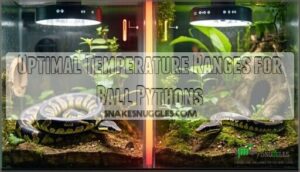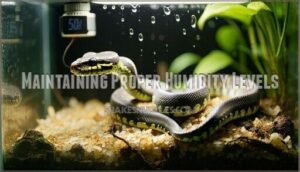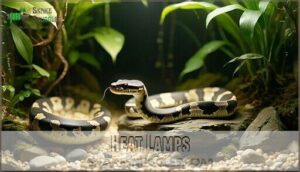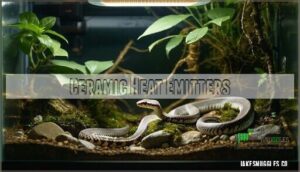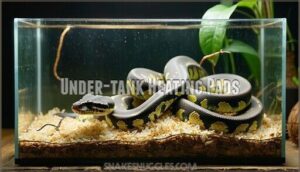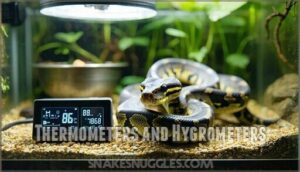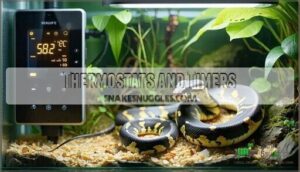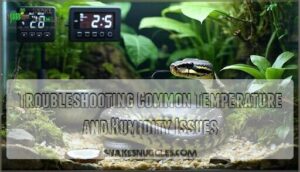This site is supported by our readers. We may earn a commission, at no cost to you, if you purchase through links.
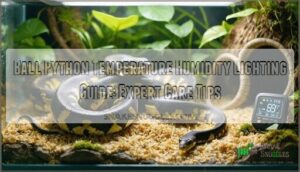
Set your basking spot to 88-92°F and keep the cool side at 78-80°F.
Maintain humidity between 50-60% using a water bowl and occasional misting.
Don’t forget lighting – a 12-hour day/night cycle helps regulate your snake’s natural rhythms.
Use under-tank heaters or ceramic emitters for consistent warmth, and always monitor with digital thermometers and hygrometers.
Getting your ball python temperature and humidity guide right isn’t rocket science, but precision matters.
Your snake’s appetite, shedding, and overall health depend on these fundamentals.
The devil’s in the details when creating the perfect habitat setup.
Table Of Contents
- Key Takeaways
- Understanding Ball Python Habitat Requirements
- Optimal Temperature Ranges for Ball Pythons
- Maintaining Proper Humidity Levels
- Essential Lighting for Ball Python Health
- Heating Equipment and Methods
- Monitoring and Regulating Environmental Conditions
- Troubleshooting Common Temperature and Humidity Issues
- Frequently Asked Questions (FAQs)
- What should my ball python’s temperature and humidity be?
- Can you leave a heat lamp on 24/7 for ball python?
- What is the best daylight for a ball python?
- Is 70% humidity too high for ball python?
- What temperature should a ball python light be?
- What is the ideal temperature and humidity for a ball python?
- What are the lighting requirements for a ball python?
- Is 75 humidity too high for ball python?
- What temperature should a ball python be?
- What is the ideal humidity level for ball pythons?
- Conclusion
Key Takeaways
- You’ll need precise temperature gradients – set your basking spot to 88-92°F and keep the cool side at 78-80°F, with nighttime temps dropping to 75-78°F to mimic your snake’s natural habitat.
- Humidity control isn’t optional – maintain 50-60% daily humidity using moisture-retaining substrates like cypress mulch, and boost it to 65-70% during shedding periods to prevent stuck sheds.
- You don’t need bright lights – establish a simple 12-hour day/night cycle with optional UVB lighting positioned 10-14 inches away, since ball pythons are naturally crepuscular and prefer gentle illumination.
- Digital monitoring tools are essential – invest in reliable thermometers, hygrometers, and thermostats to track conditions daily, because your snake’s health depends on consistent environmental precision.
Understanding Ball Python Habitat Requirements
You’ll need to recreate the specific temperature, humidity, and lighting conditions that ball pythons experience in their native West African grasslands and forests.
Understanding these natural habitat requirements forms the foundation for maintaining your snake’s health and ensuring proper digestion, shedding, and overall well-being in captivity.
Natural Environment
Understanding your ball python’s African origins helps you create the perfect home environment.
These snakes naturally inhabit West and Central Africa’s grasslands and savannas, where they’ve mastered the art of survival through specific behaviors.
Your python’s natural habitat includes these key features:
- Burrowing behavior in mammal holes for security
- Diurnal activity peaks during dawn and dusk
- Wild diet consisting of small mammals and birds
- Habitat variations from woodlands to open savannas
- Natural behaviors adapted to seasonal changes
Replicating Conditions in Captivity
Creating the perfect ball python habitat means transforming your enclosure into a slice of West African wilderness. Your snake’s well-being depends on matching their natural environment as closely as possible.
Enclosure Size matters—aim for a 40-gallon minimum for adults.
Substrate Choice should include 4 inches of moisture-retentive materials like cypress mulch or coconut fiber. This depth supports natural burrowing behaviors while maintaining proper ball python humidity levels.
Aspect Details
Substrate
Ventilation
Heating
Lighting
Strategic Hides Placement creates security—position one on each temperature zone.
Add Enrichment Items like branches and Naturalistic Decor to encourage exploration.
Proper ball python temperature gradients and ball python lighting complete this reptile environment, ensuring your ball python habitat mirrors their African homeland perfectly.
Optimal Temperature Ranges for Ball Pythons
You’ll need to maintain specific temperature zones in your ball python’s enclosure to keep your snake healthy and comfortable.
Creating the right temperature gradient allows your python to regulate its body temperature naturally, just like it would in the wild.
Basking Area Temperature
Your ball python’s basking spot serves as their personal warming station. The basking gradient should reach 88-92°F, measured with a reliable digital thermometer placed directly on the surface material.
Position your heat lamp above a flat rock or ceramic tile to create consistent warmth. Thermostat control prevents dangerous overheating that could harm your snake.
Safe basking requires careful measuring temperatures throughout the day. Here’s what you’ll need for ideal ball python temperature management:
- Digital probe thermometer for accurate surface readings
- Infrared temperature gun for quick spot-checks
- Timer-controlled heat lamp to maintain consistent warmth
Cool Side Temperature
Your ball python’s cool side temperature should stay between 75-80°F to create a proper temperature gradient.
This cool side gradient lets your snake move away from heat when needed.
Thermoregulation importance can’t be overstated—without this ambient temperature range, your python faces serious health consequences.
Achieving consistency in your reptile temperature gradient requires careful monitoring and adjustment.
Nighttime Temperature
Your ball python needs cooler nighttime temperatures to stay healthy.
Drop the temperature to 75-78°F during evening hours. This cooling period mimics nature and supports your snake’s well-being. Minimum temperatures shouldn’t fall below 75°F to avoid stress.
Cooling benefits include:
- Mimicking Nature – Replicates natural temperature drops
- Health Implications – Supports immune function
- Heating Alternatives – Ceramic emitters work well
- Natural Rhythms – Encourages nocturnal behavior
Maintaining Proper Humidity Levels
You’ll need to maintain humidity levels between 50% and 60% for your ball python’s daily comfort and health. Proper humidity prevents shedding problems and respiratory issues that can seriously harm your snake.
Daytime Humidity
Your ball python needs daytime humidity between 60-80% for ideal health.
Substrate choice like cypress mulch retains moisture effectively. Humidity sources include water bowls and light misting.
Monitoring tools like digital hygrometers track humidity levels accurately.
Proper ball python humidity prevents shedding problems and respiratory issues.
| Humidity Level | Snake Behavior | Health Impact |
|---|---|---|
| 40-50% | Restless, frequent hiding | Dehydration risk |
| 60-70% | Active, normal appetite | Optimal health |
| 70-80% | Comfortable movement | Perfect shedding |
| 80-90% | Seeking cooler spots | Stress signs |
| 90%+ | Lethargy, mouth breathing | Respiratory danger |
Nighttime Humidity
While daytime humidity stays moderate, nighttime humidity for your ball python should increase to 80-100%.
This natural spike mimics their wild habitat where moisture rises after dark.
Use a hygrometer to monitor these levels carefully.
Achieve proper nighttime humidity through gentle misting or maintaining humidity hides with damp sphagnum moss.
Proper humidity prevents shedding problems and respiratory infections.
Choose substrates that retain moisture well while preventing mold growth, supporting your snake’s respiratory health throughout the night.
Humidity for Shedding
When your ball python starts shedding, increase humidity levels to 70-80%.
Shedding season calls for extra moisture—your python’s skin will thank you for the humidity boost.
This humidity boost helps avoid stuck sheds.
Mist more often, and choose a substrate like coco coir to hold moisture.
Add a humidity hide filled with damp sphagnum moss for extra support.
Proper reptile humidity guarantees smooth shedding, keeping your snake healthy and stress-free during its regular shedding frequency.
Essential Lighting for Ball Python Health
You don’t need bright lights for your ball python since they’re crepuscular animals that are most active during dawn and dusk.
However, establishing a consistent 12-hour day/night cycle with optional UVB lighting can support their natural rhythms and promote better health through vitamin D3 synthesis.
UVB Lighting Benefits
Why add UVB lighting to your ball python’s setup? While not essential for survival, reptile UVB lighting offers impressive benefits that enhance your snake’s quality of life.
UVB exposure triggers vitamin D3 synthesis, supporting stronger bones and better calcium absorption. Your python’s immune support system gets a boost too, helping fight off infections more effectively.
Key UVB lighting benefits include:
- Enhanced natural behavior patterns and activity levels
- Improved reproductive health and breeding success
- Better visual perception of their environment
- Stronger metabolic processes throughout their body
Proper bulb placement and light duration maximize these advantages. Studies show ball pythons exhibit UVB basking behavior, suggesting potential benefits beyond vitamin D synthesis.
Day/Night Cycle
Your snake’s circadian rhythm depends on consistent lighting cycles to maintain healthy activity patterns.
Establish a 12-hour daynight cycle using low-intensity UVB lighting positioned outside the enclosure.
This lighting needs schedule prevents light sensitivity while supporting natural behavioral impacts.
Proper snake lighting creates enrichment strategies that regulate when your python explores, feeds, and rests, mimicking their wild environment perfectly, which is crucial for maintaining a healthy circadian rhythm and supporting natural behavioral impacts.
Heating Equipment and Methods
You’ll need reliable heating equipment to maintain your ball python’s temperature gradient between the warm and cool sides of the enclosure.
Heat lamps, ceramic heat emitters, and under-tank heating pads each offer different benefits for creating the proper thermal environment your snake requires.
Heat Lamps
While proper lighting sets your snake’s natural rhythm, heat lamps provide the targeted warmth your ball python needs for healthy thermoregulation.
These versatile heat sources create precise basking spots and maintain ideal ball python temperature ranges. Maintaining the correct temperature is essential, as it substantially impacts a snake’s overall health.
Consider these heat lamp essentials for effective reptile heating:
- Infrared Benefits: Deep tissue heating promotes better digestion and activity levels
- Wattage Selection: Choose 50-100 watts based on enclosure size and room temperature
- Basking Distance: Position lamps 12-18 inches away to prevent burns while ensuring adequate heat transfer
Ceramic Heat Emitters
Ceramic heat emitters consistently deliver nighttime heating without disrupting your snake’s sleep cycle.
Unlike heat lamps, these ceramic bulbs produce zero light while maintaining ideal temperatures.
CHE placement on enclosure ceilings guarantees even heat distribution.
Choose CHE wattage based on enclosure size—typically 100-150 watts for standard setups.
Safety precautions include using ceramic emitter sockets and thermostats to prevent overheating.
Many retailers offer various heating products for reptile enclosures.
| Feature | Ceramic Emitters | Heat Lamps |
|---|---|---|
| Light Output | None | Bright visible light |
| Night Suitability | Perfect for 24/7 use | Disrupts sleep cycles |
| Heat Distribution | Even infrared warmth | Concentrated hot spots |
Under-tank Heating Pads
Under-tank heating pads work differently than overhead heat sources, warming your ball python’s enclosure from below.
Pad placement requires careful consideration – position them under one-third of the tank’s floor space. Always use a substrate barrier to prevent direct contact and guarantee burn prevention.
Thermostat control is essential for safe temperature control. Many owners find reliable thermostat options essential for maintaining consistent temperatures.
Heat mat pad wattage should match your enclosure size for ideal heat sources management.
Monitoring and Regulating Environmental Conditions
You can’t maintain proper ball python care without accurate monitoring tools to track temperature and humidity levels throughout the enclosure.
Digital thermometers, hygrometers, and thermostats work together to guarantee your snake’s environment stays within the safe ranges needed for ideal health, which is crucial for ideal health.
Thermometers and Hygrometers
Monitoring your ball python’s environment requires accurate instruments. Digital thermometer and hygrometer devices outperform analog versions in precision and reliability.
Temperature monitoring and humidity monitoring become second nature with proper equipment placement and regular calibration. Accurate readings require a reliable digital device.
Here’s your monitoring checklist:
- Digital vs. Analog: Choose digital devices for superior accuracy
- Placement Strategies: Position hygrometers near substrate on cool side
- Calibration Importance: Test instruments monthly against known standards
- Accuracy Matters: Verify readings with backup devices periodically
- Monitoring Frequency: Check levels daily, especially during shedding periods
Thermostats and Timers
Digital thermostats provide precise temperature control and prevent overheating in your ball python’s habitat.
Choose pulse proportional models for heating pads or dimming types for ceramic emitters. Digital timers maintain consistent light cycles automatically, supporting your snake’s natural rhythm.
This combination guarantees energy efficiency while regulating temperature, humidity, and lighting without constant manual adjustments.
Proper humidity prevents respiratory and skin issues.
Troubleshooting Common Temperature and Humidity Issues
Even experienced ball python owners encounter temperature and humidity problems that can affect their snake’s health.
You’ll learn practical solutions to fix common issues like low humidity levels and overheating that occur in most enclosures.
Addressing Low Humidity
Low humidity spells trouble for your ball python’s health.
Watch for incomplete sheds and dry, wrinkled skin—clear warning signs. Quick fixes include upgrading your water bowl size, adjusting misting frequency, and improving substrate selection with moisture-retaining materials.
Combat low humidity with these proven methods:
- Add humidity boxes with damp sphagnum moss
- Increase enclosure ventilation strategically
- Upgrade substrate to coconut fiber or cypress mulch
- Monitor humidity levels with digital hygrometers
Dealing With Overheating
When overheating strikes, recognizing symptoms like excessive movement or gaping mouths signals heat exhaustion.
Immediately reduce heat sources and enhance shade provision around your snake’s cooling spot.
Implement ventilation strategies by adding airflow or adjusting vents.
Emergency cooling includes light misting for hydration methods, but avoid soaking.
Proper temperature regulation requires maintaining your temperature gradient – prevention beats scrambling for solutions when your python’s already stressed.
Frequently Asked Questions (FAQs)
What should my ball python’s temperature and humidity be?
Perfect temperatures are absolutely critical for your snake’s survival.
Keep the warm side at 88-92°F and cool side at 78-80°F.
Maintain humidity between 50-60% daily, increasing to 65-70% during shedding periods.
Can you leave a heat lamp on 24/7 for ball python?
You shouldn’t leave a heat lamp on 24/
Ball pythons need a nighttime temperature drop to mimic their natural habitat.
Instead, use a ceramic heat emitter for nighttime warmth without disturbing their day-night cycle.
What is the best daylight for a ball python?
Looking for the right lighting setup?
You’ll want ambient room lighting or low-intensity LED lights on a 12-hour cycle.
Ball pythons don’t need bright daylight—they’re naturally crepuscular and prefer gentle, indirect illumination.
Is 70% humidity too high for ball python?
Yes, 70% humidity is too high for your ball python’s daily needs. You’ll risk respiratory infections and scale rot. Keep it between 50-60% normally, only increasing to 70% temporarily during shedding cycles.
What temperature should a ball python light be?
Your snake’s lighting setup doesn’t need scorching temperatures.
Ball pythons don’t require specific light temperatures since they’re heat-sensitive.
Keep any lights cool and use separate heating elements like ceramic emitters for warmth instead.
What is the ideal temperature and humidity for a ball python?
Your ball python needs a temperature gradient of 88-92°F on the warm side and 75-80°F on the cool side.
Maintain humidity between 50-60% daily, increasing to 65-70% during shedding periods.
What are the lighting requirements for a ball python?
Lighting luxuries aren’t necessary for ball pythons since they’re crepuscular creatures.
You’ll need a simple 12-hour day/night cycle using room lighting.
Optional UVB bulbs can boost health when positioned 10-12 inches away.
Is 75 humidity too high for ball python?
At 75% humidity, you’re pushing the upper limit for your ball python.
While it won’t cause immediate harm, sustained levels above 70% can promote mold growth and bacterial infections, so dial it back slightly.
What temperature should a ball python be?
Your pet needs a warm side at 88-92°F and a cool side at 76-80°F.
This temperature gradient lets your snake regulate its body temperature naturally.
Nighttime temperatures shouldn’t drop below 75°F.
What is the ideal humidity level for ball pythons?
Poor humidity kills more ball pythons than most owners realize.
You’ll want to maintain 50-60% humidity daily, bumping it up to 65-70% during shedding.
Use a hygrometer to monitor levels consistently.
Conclusion
Congratulations, you’ve survived the epic journey of becoming a ball python’s personal climate control manager.
Master this ball python temperature humidity lighting guide, and your snake will reward you with proper feeding, smooth sheds, and zero dramatic hunger strikes.
Remember, these aren’t suggestions—they’re requirements.
Your python doesn’t care about your budget or convenience.
Stick to 88-92°F basking temps, 50-60% humidity, and consistent day/night cycles.
Your snake’s health depends on your commitment to precision.
- https://www.chewy.com/education/reptile-and-amphibian/snake/ball-python
- https://www.petmd.com/reptile/ball-python-care-sheet
- https://www.jabberwockreptiles.com/news/ball-python-temperature/
- https://www.hvreptilerescue.org/resources/care-guides/ball-python-care-guide
- https://www.happydragons.com/reptiles/ball-python/care-guide

